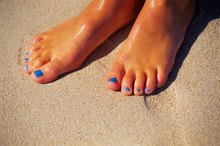What does fact checked mean?
At Healthfully, we strive to deliver objective content that is accurate and up-to-date. Our team periodically reviews articles in order to ensure content quality. The sources cited below consist of evidence from peer-reviewed journals, prominent medical organizations, academic associations, and government data.
The information contained on this site is for informational purposes only, and should not be used as a substitute for the advice of a professional health care provider. Please check with the appropriate physician regarding health questions and concerns. Although we strive to deliver accurate and up-to-date information, no guarantee to that effect is made.
Itchy Skin From Chlorine
Compounds containing chlorine keep pools and hot tubs sanitary, but exposure to the chemical poses some health risks. Low levels of skin exposure can cause eye and skin irritation. Higher levels can result in severe burns and ulcerations. Chlorine can also strip away your skin’s protective oils, which can make it dry and itchy.
Effects on Your Skin
Exposure to chlorine can cause contact dermatitis, or skin inflammation resulting from direct contact with an irritant 5. Symptoms may be a red rash and severe itching, as well as blisters in severe cases. The drying effects of chlorine and water may also cause itchiness without a rash.
- Exposure to chlorine can cause contact dermatitis, or skin inflammation resulting from direct contact with an irritant 5.
- The drying effects of chlorine and water may also cause itchiness without a rash.
What to Do
Skin Problems Following Chlorine Contact
Learn More
When you start itching from chlorine, get out of the pool and limit your exposure to the chemical. Chlorine-related rash and itching typically subsides within two to four weeks. Hydrocortisone creams help relieve the itchiness. In severe cases, you might need to consult a doctor for oral corticosteroids and antihistamines to relieve itching and inflammation.
- When you start itching from chlorine, get out of the pool and limit your exposure to the chemical.
- In severe cases, you might need to consult a doctor for oral corticosteroids and antihistamines to relieve itching and inflammation.
Next Time
Before you swim, slather on a moisturizer, such as petrolatum, on the areas of your body most susceptible to itching to minimize the irritation from chlorine exposure. Shower or bathe after your swim using a mild, moisturizing soap. Allowing chlorine to stay on your skin after you swim can dry out your skin and make it more prone to irritation. After showering off, apply a thick moisturizing cream to help seal in your skin’s moisture.
- Before you swim, slather on a moisturizer, such as petrolatum, on the areas of your body most susceptible to itching to minimize the irritation from chlorine exposure.
Signs of Trouble
Can I Get Relief from Poison Ivy in a Swimming Pool?
Learn More
A rash that appears within a few days of soaking in a hot tub might be hot tub folliculitis, a type of skin infection 2. Hot tub rash, or hot tub folliculitis, occurs when bacteria infect your skin 2. Itchy spots on your skin may develop into a red, bumpy rash with pus-filled blisters around the hair follicles. Although the rash is a nuisance, the Centers for Disease Control and Prevention reports that it usually clears up without treatment within a few days 1.
Chlorine Levels
Properly maintained hot tubs and pools are less likely to spread germs and cause skin irritation. According to the CDC, pool operators should check chlorine and pH levels twice a day. Optimal chlorine levels are 1 to 3 parts per million. An optimal pH level is between 7.2 to 7.8. Ensure that your own pool or hot tub is properly maintained, and frequent facilities that follow CDC guidelines.
- Properly maintained hot tubs and pools are less likely to spread germs and cause skin irritation.
- According to the CDC, pool operators should check chlorine and pH levels twice a day.
Related Articles
References
- Centers for Disease Control and Prevention: Hot Tub Rash
- Medline Plus: Hot Tub Folliculitis
- MedlinePlus: Chlorine Poisoning
- New York State Department of Health: The Facts About Chlorine
- MedlinePlus: Contact Dermatitis
- Novak-Bilić G, Vučić M, Japundžić I, Meštrović-Štefekov J, Stanić-Duktaj S, Lugović-Mihić L. Irritant and allergic contact dermatitis - skin lesion characteristics. Acta Clin Croat. 2018;57(4):713–720.
- Centers for Disease Control and Prevention. Rashes. Reviewed May 4, 2016.
- Centers for Disease Control and Prevention. Parasites - Cercarial Dermatitis (also known as Swimmer's Itch). Reviewed October 22, 2018.
- Rossetto AL, Da Silveira FL, Morandini AC, Haddad V, Resgalla C. Seabather's eruption: report of fourteen cases. An Acad Bras Cienc. 2015;87(1):431-6. doi:10.1590/0001-3765201520130468
- Chaumont A, Voisin C, Sardella A, Bernard A. "Interactions Between Domestic Water Hardness, Infant Swimming and Atopy in the Development of Childhood Eczema." Environmental Research. 2012 Jul;116:52-7. DOI: 10.1016/j.envres.2012.04.013.
- Gomà A, de Lluis R, Roca-Ferrer J, Lafuente J, Picado C. "Respiratory, Ocular and Skin Health in Recreational and Competitive Swimmers: Beneficial Effect of a New Method to Reduce Chlorine Oxidant Dervatives." Environmental Research. 2017 Jan;152:315-321. DOI: 10.1016/j.envres.2016.10.030.
- Khodaee M, Edelman GT, Spittler J, et. al. "Medical Care for Swimmers." Sports Medicine Open. 2016 Dec; 2: 27. DOI: 10.1186/s40798-016-0051-2.
- Salvaggio HL, Scheman AJ, Chamlin SL. "Shock Treatment: Swimming Pool Contact Dermatitis." Pediatric Dermatology. 2013 Jul-Aug;30(4):494-5. DOI: 10.1111/pde.12017.
Writer Bio
A former children's librarian and teacher living in Dallas, Erin Carson loves to share her knowledge of both literature and parenting through her writing. Carson has a master's degree in library science and a bachelor's degree in English literature. As a freelance writer, Carson has published numerous articles on various websites.









